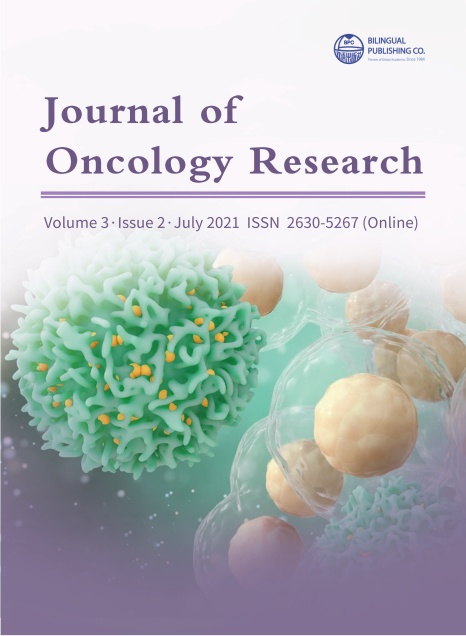Fertility Cancer and Hereditary Risks in Soil Sample of Nasarawa, Nasarawa State, Nigeria
DOI:
https://doi.org/10.30564/jor.v3i2.3633Abstract
A survey of Fertility Cancer and Hereditary Risks in Soil Sample of Nasarawa was carried out. This study assessed the level of Fertility Cancer and Hereditary Risks in some part of Nasarawa using the gamma-ray spectrometry. The mean concentration for 40K was 645.29 ± 07.32 Bq/kg, for 226Ra was 28.43 ± 4.8422 Bq/Kg and for 232Th was 66.84 ± 2.0201 Bq/Kg. The average effective dose due to the ingestion was 0.36±0.1µSv/y which was approximately 1000 times lower than the world average effective dose. Radium equivalent activity Raeq (Bq/kg), alpha index and total cancer risk were found to be 161.44±8.08 Bq/kg, 0.142±0.02 and (0.21±0.05) ×10-5 respectively. UNSCEAR/ USEPA stipulated that; radium equivalent activity, alpha index, effective dose and total cancer risk should not exceed the limit of 370 Bq/kg, unity, 300 µSv/y and 1 ×10-4 respectively. Hence the values obtained in this work were within the acceptable limits. This implies that the ingestion or inhalation of soil is not associated with any radiological risk of concern.
Keywords:
Absorbed dose; Effective dose; Natural radioactivity; Radium equivalent activity; Internal hazard index; γ-ray spectrometryReferences
[1] Al-Jundia, J., Al-Bataina, B.A., Abu-Rukah, Y., Shehadeh, H.M (2003). Natural Radioactivity
[2] Concentrations in Soil Samples along the Amman Aqaba Highway.
[3] Chikasawa, K. , Ishii, T. and Ugiyama, H (2001). Terrestrial gamma radiation in Kochi Prefecture, Japan.
[4] Goddard C.C (2002); Measurement of outdoor terrestrial gamma radiation in the Sultanate of Oman.
[5] Obed, R.I, Farai, I.P. and Jibiri, N.N (2005). Population dose distribution due to soil radioactivity concentration levels in 18 cities across Nigeria.
[6] Orabi, O., Al-Shareaif, A. and El Galefi, M (2006). Gamma- Ray measurements of naturally occurring radioactive sample from Alkharje City.
[7] Singh, S. and Rani, A (2005). Natural radioactivity levels in soil samples from some areas of Himachal Pradesh, India using γ- ray spectrometry.
[8] Tso, M.Y. and Leung, J.K (2000). Population dose due to natural radiations in Hong Kong.
[9] Tettey-Larbi, L., Darko, E.O., Schandorf, C. and Appiah, A.A (2013). Springer Plus. 2, 1. Tettey- Larbi et al. Springer Plus 2013, 2:157. http://www.springerplus.com/content/2/1/157.
[10] Njinga, R., Jonah, S. and Gomina, M., Radiat, J (2015). Research. Applied. Sciences. 8 (2), 208. doi:10.1016/j. jrras.2015.01.001.
[11] UNSCEAR. Effects of Ionizing Radiation, 2000 Report to the General Assembly, with Scientific Annexes, United Nations, New York Report to the General Assembly, 2000.
[12] Beretka, J. and Mathew, P (1985). Health Physics. 48 (1), 87. https://journals.lww.com/health physics/Abstract/1985/01000/ Natural Radioactivity of Australian Building.7.aspx.
[13] Garba, N.N., Ramli, A.T., Saleh, M.A. and Gabdo, H.T (2019). Human Ecol. Risk Ass. An Internat. J. 25 (7), 1707. doi:10.1080/10807039.2018.1474433.
[14] Jibiri, N. A., Mbawanku, A., Oridata and Nigeria, U.C. (1999). Nig. J. Phys. 11, 12.
[15] ICRP. Recommendations of the International Commission on Radiological Protection, Natural radionuclide concentration levels in soil and water around cement factory. http://www.icrp.org/docs/ICRP_Publication_103-Annals_of_the_ICRP_37%282-4%29-Free_extract. pdf
[16] Paul, E.F., Okibe, M., Abdullahi, H. and Toryila, J. (2014). J. Basic. Appl. Sci. Res. 4, 4. 2090-4304.https://www.textroad.com/pdf/ 4(3)48-51, % 202014.pdf.
[17] Asaduzzaman, K., Khandaker, M., Amin Y. and Bradley, D.A. (2016). Indoor Built Environ. 25 (3), 541. doi:10.1177/1420326X14562048.
[18] Xinwei, L., Lingqing, W., Xiaodan, J., Leipeng, Y. and Gelian, Radiat, D. (2006). Protec. Dosim. 118 (3), 352. doi:10.1093/rpd/nci339.
[19] Scheibel, V. and Appoloni, B.C.R. (2007). Arch. Biol. Tech. 50 (5), 901. doi:10.1590/S1516- 89132007000500019.
[20] Jevremovic, M., Lazarevic, N., Pavlovic, S. and Orlic, I.M. (2011). Environ. Health Stud. 47 (1), 87. doi:10.1080/10256016.2011.556723.
[21] Desideri, D., Meli M.A. and Roselli, C. J. (2010). Environ. Radioact. 101 (9), 751. doi:10.1016/j. jenvrad.2010.04.018.
Downloads
How to Cite
Issue
Article Type
License
Copyright and Licensing
The authors shall retain the copyright of their work but allow the Publisher to publish, copy, distribute, and convey the work.
Journal of Oncology Research publishes accepted manuscripts under Creative Commons Attribution-NonCommercial 4.0 International License (CC BY-NC 4.0). Authors who submit their papers for publication by Journal of Oncology Research agree to have the CC BY-NC 4.0 license applied to their work, and that anyone is allowed to reuse the article or part of it free of charge for non-commercial use. As long as you follow the license terms and original source is properly cited, anyone may copy, redistribute the material in any medium or format, remix, transform, and build upon the material.
License Policy for Reuse of Third-Party Materials
If a manuscript submitted to the journal contains the materials which are held in copyright by a third-party, authors are responsible for obtaining permissions from the copyright holder to reuse or republish any previously published figures, illustrations, charts, tables, photographs, and text excerpts, etc. When submitting a manuscript, official written proof of permission must be provided and clearly stated in the cover letter.
The editorial office of the journal has the right to reject/retract articles that reuse third-party materials without permission.
Journal Policies on Data Sharing
We encourage authors to share articles published in our journal to other data platforms, but only if it is noted that it has been published in this journal.




 Aims and Scope
Aims and Scope U. Rilwan
U. Rilwan


